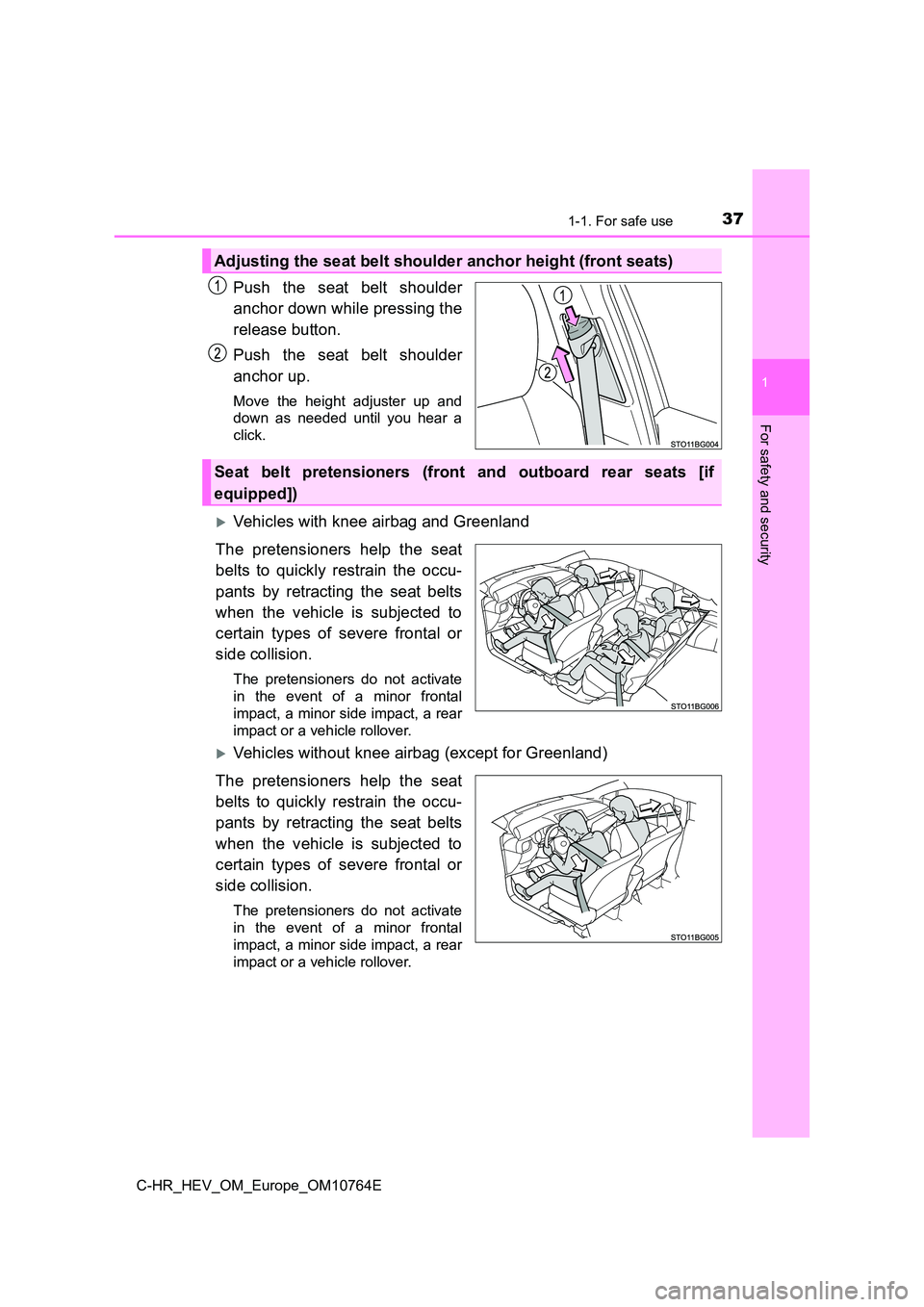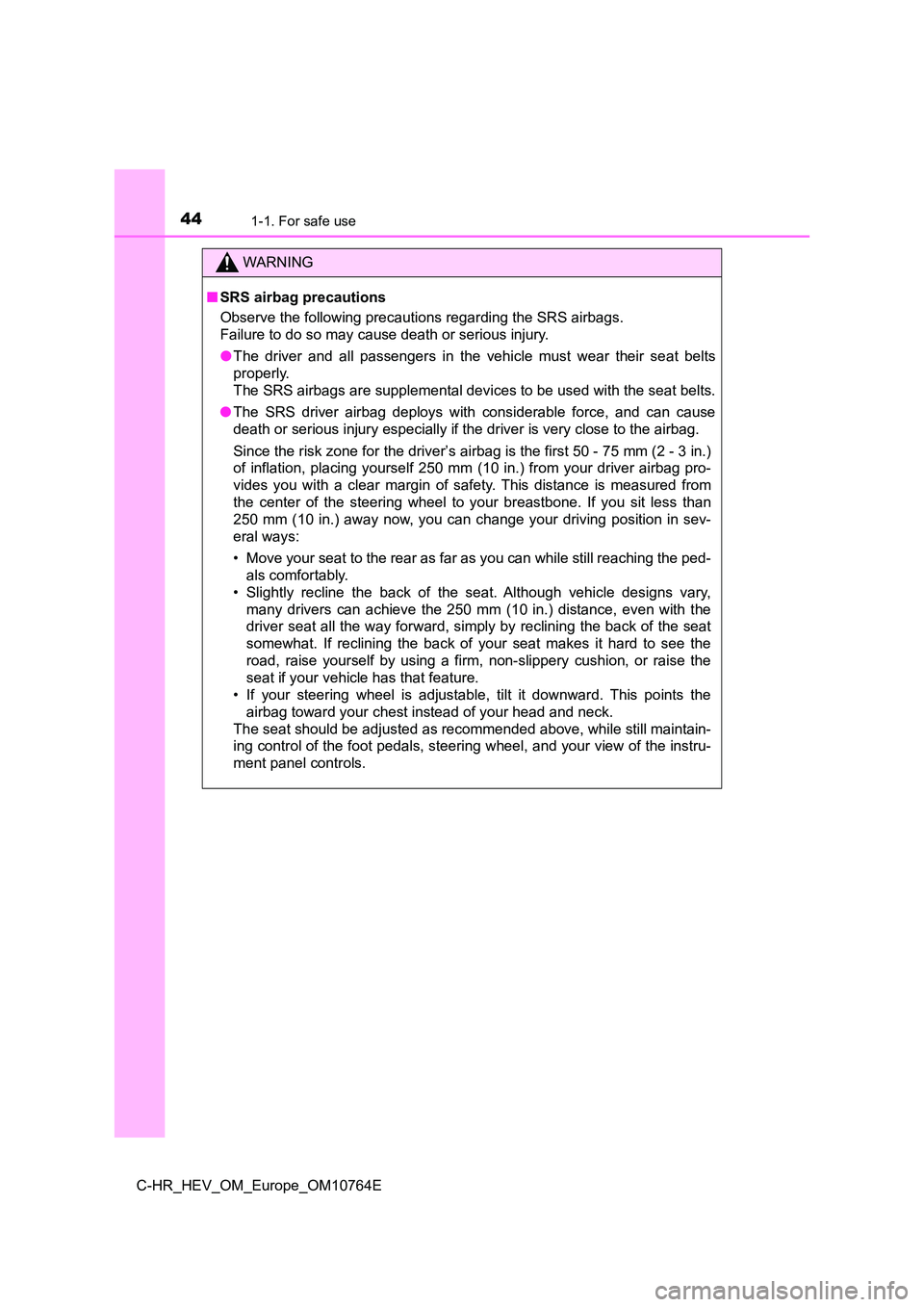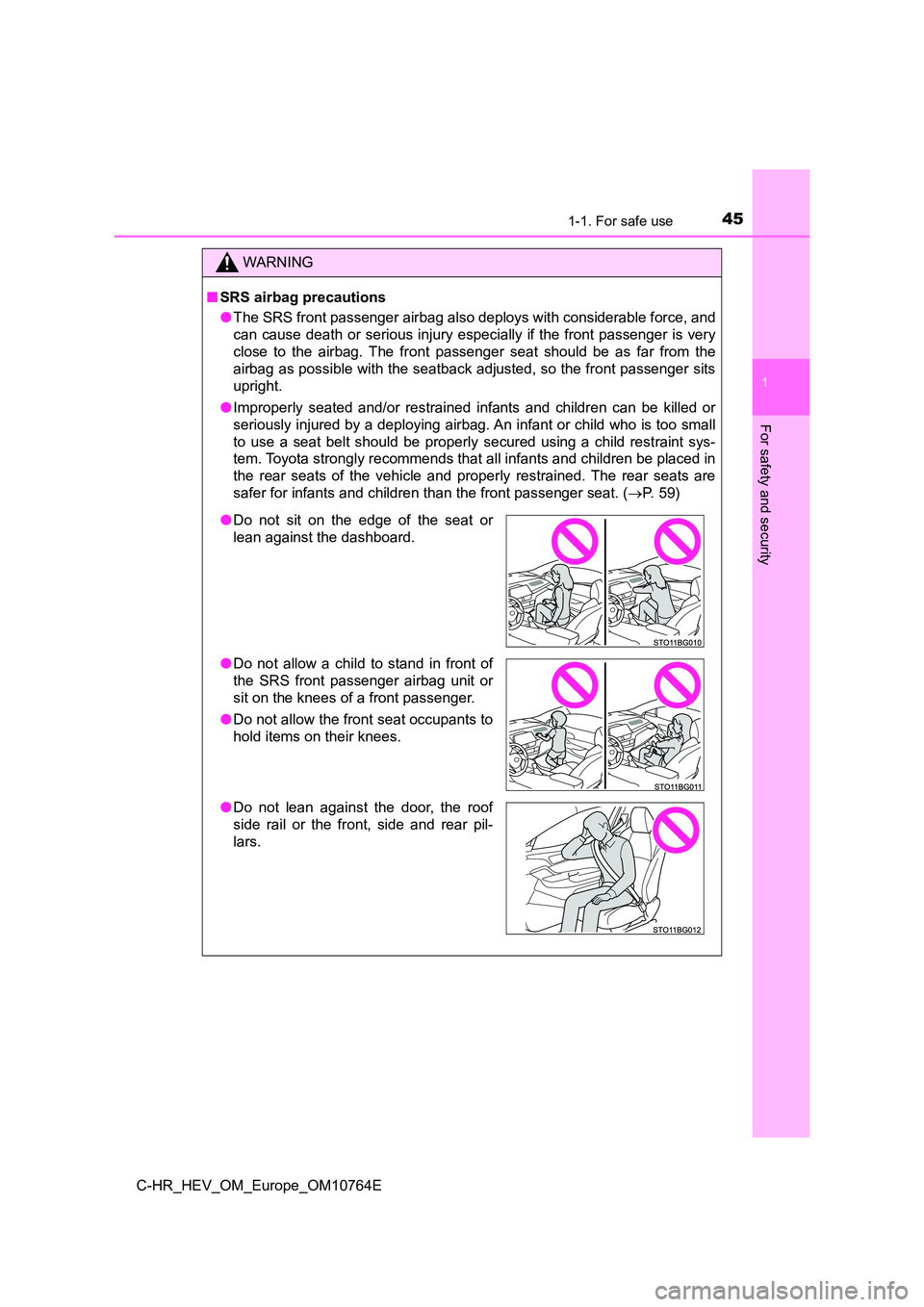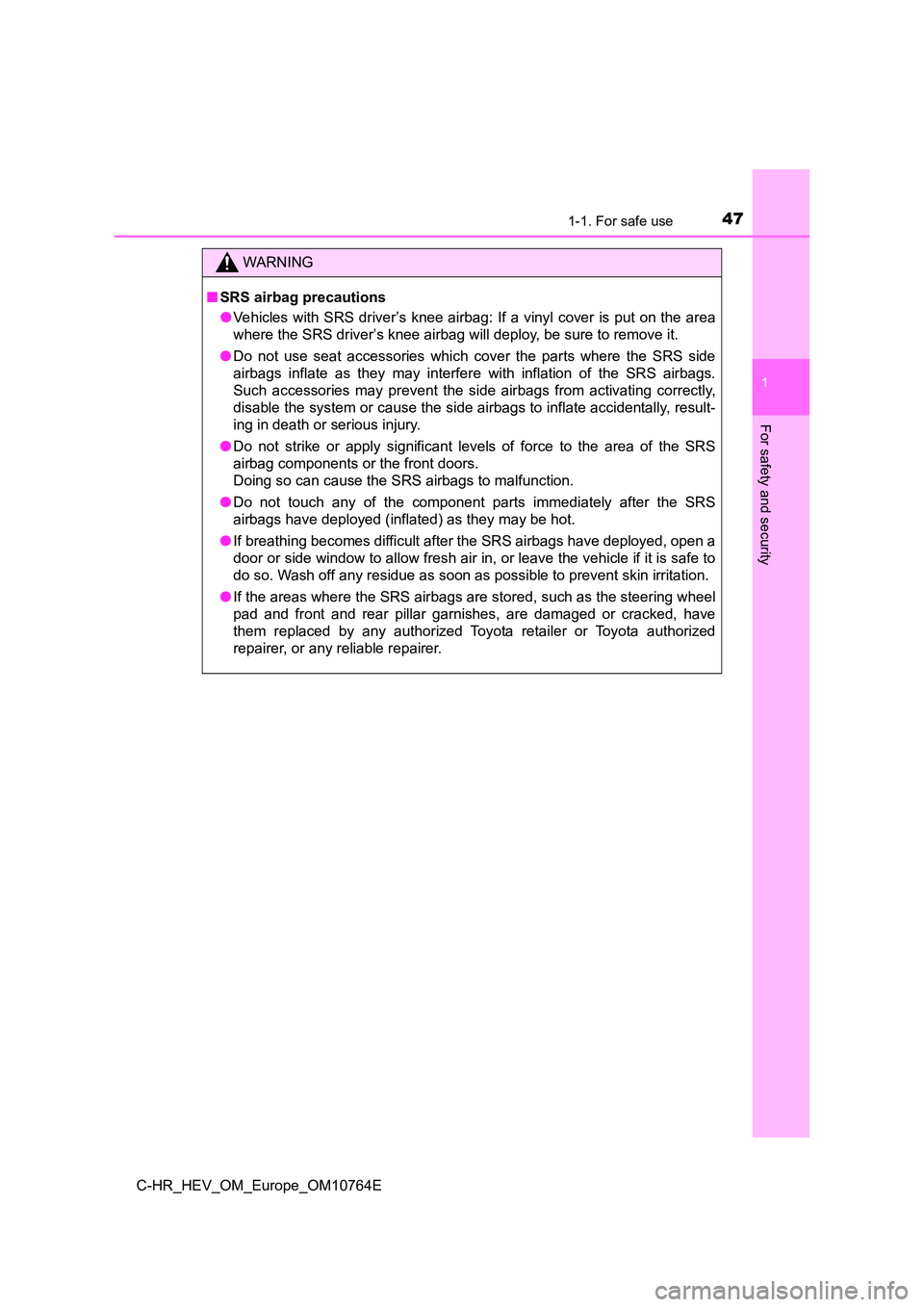Page 39 of 814

371-1. For safe use
1
For safety and security
C-HR_HEV_OM_Europe_OM10764E
Push the seat belt shoulder
anchor down while pressing the
release button.
Push the seat belt shoulder
anchor up.
Move the height adjuster up and
down as needed until you hear a
click.
Vehicles with knee airbag and Greenland
The pretensioners help the seat
belts to quickly restrain the occu-
pants by retracting the seat belts
when the vehicle is subjected to
certain types of severe frontal or
side collision.
The pretensioners do not activate
in the event of a minor frontal
impact, a minor side impact, a rear
impact or a vehicle rollover.
Vehicles without knee airbag (except for Greenland)
The pretensioners help the seat
belts to quickly restrain the occu-
pants by retracting the seat belts
when the vehicle is subjected to
certain types of severe frontal or
side collision.
The pretensioners do not activate
in the event of a minor frontal
impact, a minor side impact, a rear
impact or a vehicle rollover.
Adjusting the seat belt shoulder anchor height (front seats)
Seat belt pretensioners (front and outboard rear seats [if
equipped])
Page 43 of 814
411-1. For safe use
1
For safety and security
C-HR_HEV_OM_Europe_OM10764E
SRS airbags
◆SRS front airbags
SRS driver airbag/front passenger airbag
Can help protect the head and chest of the driver and front pas -
senger from impact with interior components
SRS driver’s knee airbag (if equipped)
Can help provide driver protection
◆SRS side and curtain shield airbags
SRS front side airbags
Can help protect the torso of the front seat occupants
SRS curtain shield airbags
Can help protect primarily the head of occupants in the outer
seats
The SRS airbags inflate when the vehicle is subjected to certai n
types of severe impacts that may cause significant injury to th e
occupants. They work together with the seat belts to help reduc e
the risk of death or serious injury.
Page 44 of 814
421-1. For safe use
C-HR_HEV_OM_Europe_OM10764E
SRS airbag system components
Page 45 of 814
431-1. For safe use
1
For safety and security
C-HR_HEV_OM_Europe_OM10764E
The main SRS airbag system components are shown above. The
SRS airbag system is controlled by the airbag sensor assembly. As
the airbags deploy, a chemical reaction in the inflators quickl y fills the
airbags with non-toxic gas to help restrain the motion of the o ccu-
pants.
Front impact sensors
Airbag manual on-off switch (if
equipped)
Front passenger airbag
“PASSENGER AIR BAG” indi-
cator (if equipped)
Side impact sensors (front)
Side impact sensors (front
door)
Seat belt pretensioners and
force limiters (front)
Side airbags
Curtain shield airbags
Driver’s seat position sensor
(if equipped)
Driver airbag
Driver’s knee airbag (if
equipped)
SRS warning light
Airbag sensor assembly
Seat belt pretensioners and
force limiters (rear outboard
seats) (if equipped)
Page 46 of 814

441-1. For safe use
C-HR_HEV_OM_Europe_OM10764E
WARNING
■SRS airbag precautions
Observe the following precautions regarding the SRS airbags.
Failure to do so may cause death or serious injury.
● The driver and all passengers in the vehicle must wear their seat belts
properly.
The SRS airbags are supplemental devices to be used with the se at belts.
● The SRS driver airbag deploys with considerable force, and can cause
death or serious injury especially if the driver is very close to the airbag.
Since the risk zone for the driver’s airbag is the first 50 - 7 5 mm (2 - 3 in.)
of inflation, placing yourself 250 mm (10 in.) from your driver airbag pro-
vides you with a clear margin of safety. This distance is measu red from
the center of the steering wheel to your breastbone. If you sit less than
250 mm (10 in.) away now, you can change your driving position in sev-
eral ways:
• Move your seat to the rear as far as you can while still reach ing the ped-
als comfortably.
• Slightly recline the back of the seat. Although vehicle design s vary,
many drivers can achieve the 250 mm (10 in.) distance, even wit h the
driver seat all the way forward, simply by reclining the back o f the seat
somewhat. If reclining the back of your seat makes it hard to s ee the
road, raise yourself by using a firm, non-slippery cushion, or raise the
seat if your vehicle has that feature.
• If your steering wheel is adjustable, tilt it downward. This p oints the
airbag toward your chest instead of your head and neck.
The seat should be adjusted as recommended above, while still m aintain-
ing control of the foot pedals, steering wheel, and your view o f the instru-
ment panel controls.
Page 47 of 814

451-1. For safe use
1
For safety and security
C-HR_HEV_OM_Europe_OM10764E
WARNING
■SRS airbag precautions
● The SRS front passenger airbag also deploys with considerable force, and
can cause death or serious injury especially if the front passe nger is very
close to the airbag. The front passenger seat should be as far from the
airbag as possible with the seatback adjusted, so the front pas senger sits
upright.
● Improperly seated and/or restrained infants and children can be killed or
seriously injured by a deploying airbag. An infant or child who is too small
to use a seat belt should be properly secured using a child res traint sys-
tem. Toyota strongly recommends that all infants and children b e placed in
the rear seats of the vehicle and properly restrained. The rear seats are
safer for infants and children than the front passenger seat. ( P. 59)
●Do not sit on the edge of the seat or
lean against the dashboard.
● Do not allow a child to stand in front of
the SRS front passenger airbag unit or
sit on the knees of a front passenger.
● Do not allow the front seat occupants to
hold items on their knees.
● Do not lean against the door, the roof
side rail or the front, side and rear pil-
lars.
Page 48 of 814
461-1. For safe use
C-HR_HEV_OM_Europe_OM10764E
WARNING
■SRS airbag precautions
●Do not allow anyone to kneel on the
passenger seat toward the door or put
their head or hands outside the vehicle.
● Vehicles without SRS driver’s knee
airbag: Do not attach anything to or lean
anything against areas such as the
dashboard or steering wheel pad.
These items can become projectiles
when the SRS driver and front passen-
ger airbags deploy.
Vehicles with SRS driver’s knee airbag:
Do not attach anything to or lean any-
thing against areas such as the dash-
board, steering wheel pad and lower
portion of the instrument panel.
These items can become projectiles
when the SRS driver, front passenger
and driver’s knee airbag deploy.
● Do not attach anything to areas such as
a door, windshield, side door glass,
front or rear pillar, roof side rail and
assist grip. (Except for the speed limit
label: P. 705)
Page 49 of 814

471-1. For safe use
1
For safety and security
C-HR_HEV_OM_Europe_OM10764E
WARNING
■SRS airbag precautions
● Vehicles with SRS driver’s knee airbag: If a vinyl cover is put on the area
where the SRS driver’s knee airbag will deploy, be sure to remo ve it.
● Do not use seat accessories which cover the parts where the SRS side
airbags inflate as they may interfere with inflation of the SRS airbags.
Such accessories may prevent the side airbags from activating c orrectly,
disable the system or cause the side airbags to inflate acciden tally, result-
ing in death or serious injury.
● Do not strike or apply significant levels of force to the area of the SRS
airbag components or the front doors.
Doing so can cause the SRS airbags to malfunction.
● Do not touch any of the component parts immediately after the SRS
airbags have deployed (inflated) as they may be hot.
● If breathing becomes difficult after the SRS airbags have deployed, open a
door or side window to allow fresh air in, or leave the vehicle if it is safe to
do so. Wash off any residue as soon as possible to prevent skin irritation.
● If the areas where the SRS airbags are stored, such as the steering wheel
pad and front and rear pillar garnishes, are damaged or cracked , have
them replaced by any authorized Toyota retailer or Toyota autho rized
repairer, or any reliable repairer.